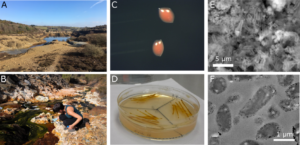Mine waste is a serious global environmental issue. Poorly-managed mine wastes are responsible for polluting our environment with toxic metals and metalloids. Microbes can live in mine wastes, even when they contain high levels of metals. These microbes can lessen the environmental impact of mine wastes by helping them become colonised by plants, and by changing the metals into forms that are less mobile in the environment. For example, some microbes can make minerals that stop metals dissolving into rainwater, and therefore prevent them from ending up in rivers. But on the other hand, some microbes can increase the amount of metals that dissolve into waters by producing acidity. This article describes the impact of microbial activity on the metals most commonly found in mine wastes, and how we can encourage beneficial microbial activities to reduce the environmental impact of mine wastes.
Newsome L, Falagán Rodriguez C, 2021. The microbiology of metal mine waste, bioremediation applications and implications for planetary health. GeoHealth, e2020GH000380. https://doi.org/10.1029/2020GH000380

Figure 2: Environments impacted by acid-generating mine waste and examples of the microbes responsible